


Bolt.new is an AI-driven development platform from StackBlitz that turns text prompts into full-stack web applications in your browser.
Despite its capabilities, users hit limitations with Bolt.new as their projects grow. Common pain points include limited scalability for large-scale apps, its token-based pricing model that quickly burns through budgets, and the need for real coding skills to debug and refine output.
Below, we’ll compare a range of Bolt.new competitors from no-code app builders like Glide to AI-assisted IDEs like Cursor and enterprise app platforms like Superblocks, so you can pick the right fit.
Best Bolt.new alternatives comparison table: TL;DR
Before diving into the full breakdowns, here’s a quick side-by-side look at how the top Bolt alternatives stack up on pricing and key strengths:
1. Superblocks
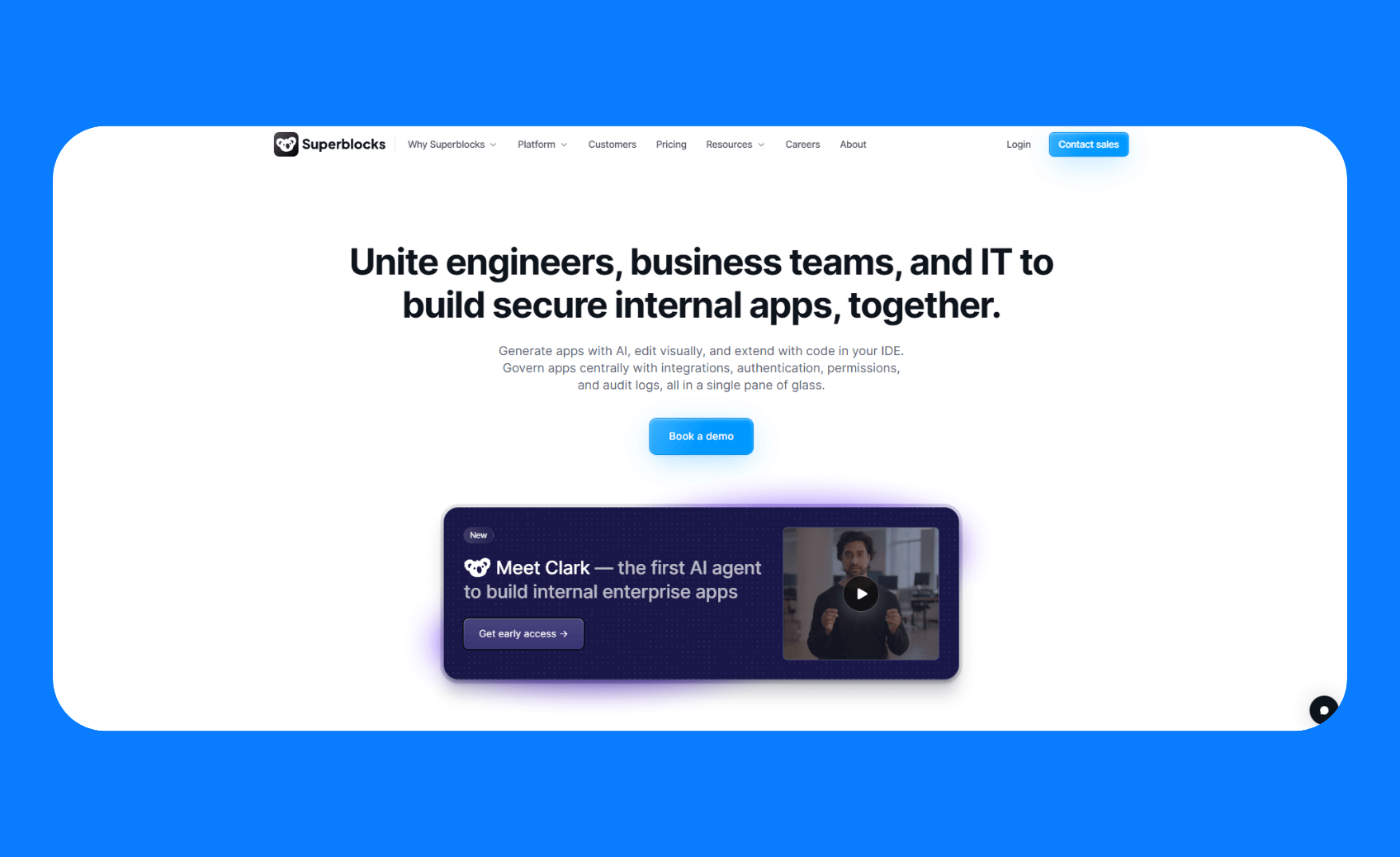
What it does: Superblocks is an AI internal app development platform that helps operationally complex enterprises solve shadow IT/AI and engineering bottlenecks with a secure, centrally governed platform.
Who it’s for: Organizations and enterprises that want to empower business or ops teams to create internal tools safely, without bypassing IT governance.
Key features
- Multi-modal editing: You can build and modify apps with Clark AI, refine with the WYSIWYG visual editor, or make direct code edits in your preferred IDE.
- Centralized governance: Superblocks supports RBAC, SSO, granular permissions, audit logging, and observability managed from one central dashboard.
- AI app generation with guardrails: Clark AI is aware of your security policies, design standards, and coding best practices.
- Extensive integrations: Superblocks connects to virtually any API (e.g., REST, gRPC, GraphQL, and OpenAPI) and databases. It also integrates with your SDLC processes, such as Git workflows and CI/CD pipelines.
Pros
- Production-ready output: Clark generates maintainable React code that adheres to your company’s coding conventions and security standards.
- Eliminates IT bottlenecks: Business teams can self-serve to build internal tools quickly, without waiting on scarce developer resources, yet IT still has full visibility and control.
- AI safeguards: Superblocks sends only minimal, necessary context to the LLM and never trains on your data. All data in transit is encrypted.
Cons
- Focused scope: Clark is optimized for internal business apps and not for general consumer-facing app development.
Pricing
Superblocks uses custom pricing based on the number of builders, end-users, and the deployment model used. You’ll need to contact sales for a quote or book a demo.
Bottom line: Superblocks offers the governance and security controls enterprises need to keep internal app development secure. Consider it if you need to democratize app building across teams and avoid the risks that come with AI app generation.
2. Lovable

What it does: Lovable is an AI-first app generator that lets you create full-stack web apps by chatting with an AI. It generates a React/Tailwind frontend and uses Supabase backend for authentication and data management.
Who it's for: Product managers, designers, or entrepreneurs can use it to spin up an MVP or prototype without writing code.
Key features
- GitHub integration: Lovable syncs the generated apps to your GitHub repo. You can extend the code locally, and Lovable will sync with it when you push it back to GitHub.
- Integrated Supabase backend: Lovable automatically sets up a Supabase backend for you if you connect to your Supabase account. Your app gets a Postgres database, an authentication system, and file storage.
- Visual and chat-based interface: You can use text, screenshots, Figma, or Excalidraw inputs to generate UI and logic.
Pros
- No-code with code optional: Lovable empowers people with zero coding skills to create usable software. But you can still export and modify the code.
- Low barrier and upfront cost: Lovable’s free tier lets you do a handful of generations per day, which is often enough to toy around or build a simple MVP.
- Flexible input methods: Accept sketches, screenshots, and natural language descriptions.
Cons
- MVP-scale only: Lovable is best for prototypes and lightweight apps. Users report it may not scale well for large, complex enterprise applications.
- Complex projects require more iterations: You need more iterations to build more complex logic, which can get expensive.
Pricing
Lovable’s free tier supports up to 5 generations per day, capped at 30 per month. Paid plans start at $25/month. It supports 100 generation credits/month + 5 that renew daily, private projects, and a custom domain. Higher plans include SSO and the option to opt out of AI models using your data for training.
Bottom line: Lovable offers similar functionality to Bolt, but it provides more out-of-the-box integrations with services like Resend, D3.js, Make, and Highcharts.
3. Cursor
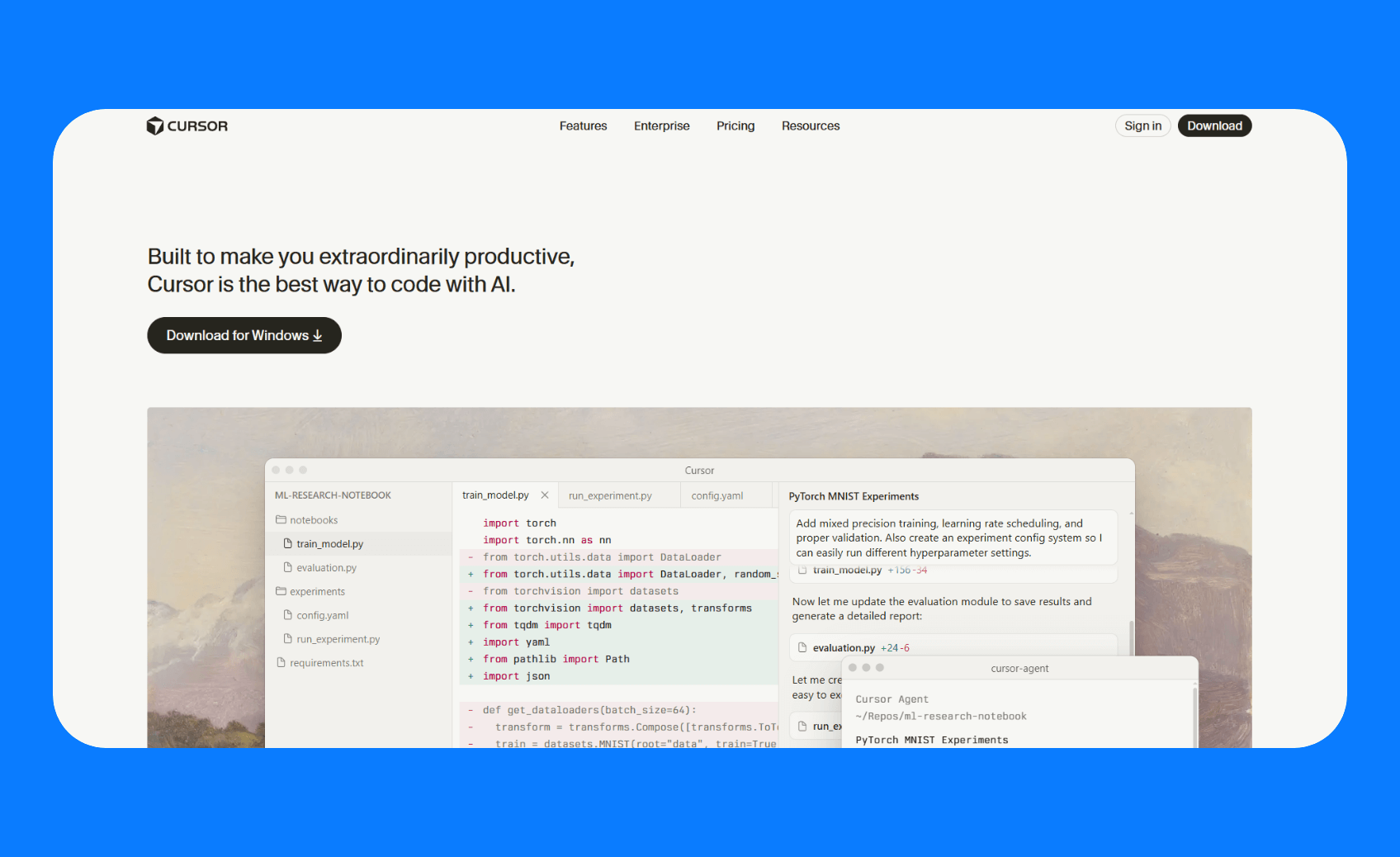
What it does: Cursor acts as an AI pair programmer inside your IDE. You can highlight code and ask Cursor’s AI to refactor it, generate unit tests, explain a bug, or create new files/functionality based on a description.
Who it's for: Developers who want AI assistance directly in their coding environment.
Key features
- In-editor AI chat & modifications: You can ask Cursor questions about your code, or give instructions like “Optimize this function” or “Implement a new API endpoint,” and it will directly modify or create code inline.
- Multi-file generation & refactoring: Cursor’s AI agent can plan and execute changes that span many files.
- AI-powered debugging (Bugbot): When you run your code, Cursor’s Bugbot watches for errors and can automatically suggest fixes.
Pros
- Easy to learn VS Code experience: Cursor is a VS Code fork. Developers familiar with VS Code can get started quickly. Most extensions and shortcuts work the same in Cursor.
- Context awareness: Cursor makes highly relevant suggestions tailored to the project because it indexes your entire codebase.
- Built-in AI chat and code diff tooling: AI chat supports direct codebase modifications, debugging, and brainstorming, while Composer provides inline code changes for precise control.
Cons
- Occasionally inaccurate code: Large-scale modifications or refactors can lead to subtle logic updates, import drift, and inconsistencies that require scrutiny.
- Not fully autonomous: Cursor expects you to guide the development. It won’t generate an entire app without you writing some code or prompts for each section, unlike Bolt or Lovable.
Pricing
Cursor’s hobby plan is free and supports limited agent requests and tab completions. The individual plans start at $20/month, while team plans start at $40/user/month.
Bottom line: If you’re an experienced dev or team that wants AI to boost productivity, consider Cursor.
4. v0 by Vercel
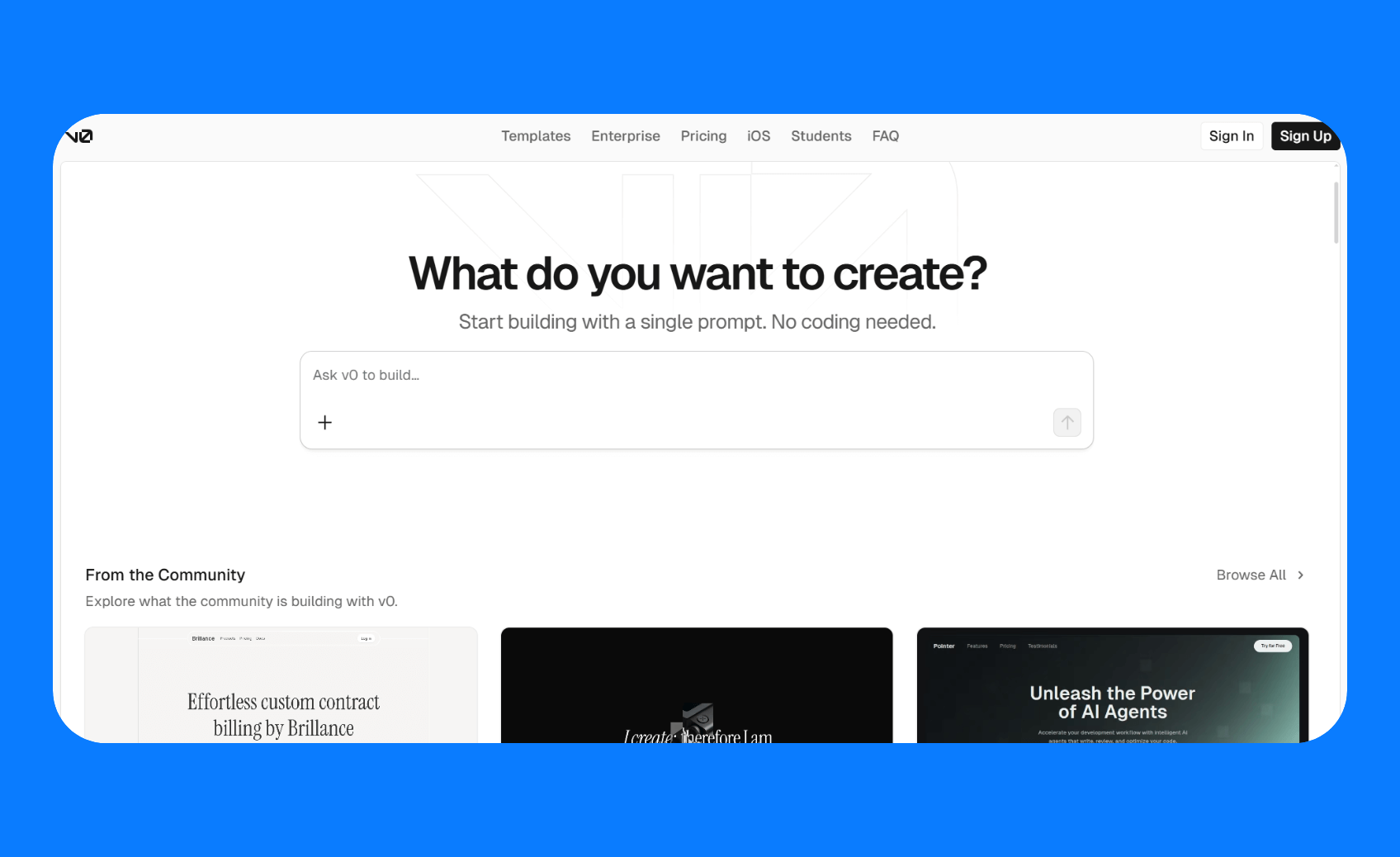
What it does: v0 from Vercel is a generative AI development tool by Vercel that turns natural language prompts into code, primarily for JavaScript-based frameworks and Tailwind CSS projects.
Who it’s for: Front-end developers, UX/UI designers, and product managers who need to build UI components and prototypes.
Key features
- Code generation with Tailwind and shadcn/UI: v0 generates front-end code using Next.js/React with Tailwind CSS, and components from shadcn/UI.
- Agentic capabilities: v0 can reason, plan, inspect code/sites, and fix errors automatically.
- API access: The v0 Platform API provides programmatic access to the v0 development infrastructure.
Pros
- Consistent, on-brand UIs: Since you can configure v0 with your design system (Tailwind theme, shadcn components), the UIs it generates will already match your brand’s style guide.
- Flexible refinement modes: You can edit the generated code directly in the browser or highlight an element in the preview and describe a change in natural language.
- One-click deploy: When your prototype is ready, you can export to a GitHub repo and deploy to Vercel with one click.
Cons
- JavaScript-centric: v0 currently supports only JS/TS frameworks like React, Vue, and Svelte.
- Not suitable for production apps: Generated code often requires manual refinement for advanced business logic.
Pricing
v0 offers a free tier that offers $5 worth of compute credits. Paid plans start at $20/month for individuals. This plan provides access to the v0 API and a higher generation limit.
Bottom line: v0 is best for teams that want a collaborative, AI-first development experience that bridges design, dev, and product workflows.
5. GitHub Spark
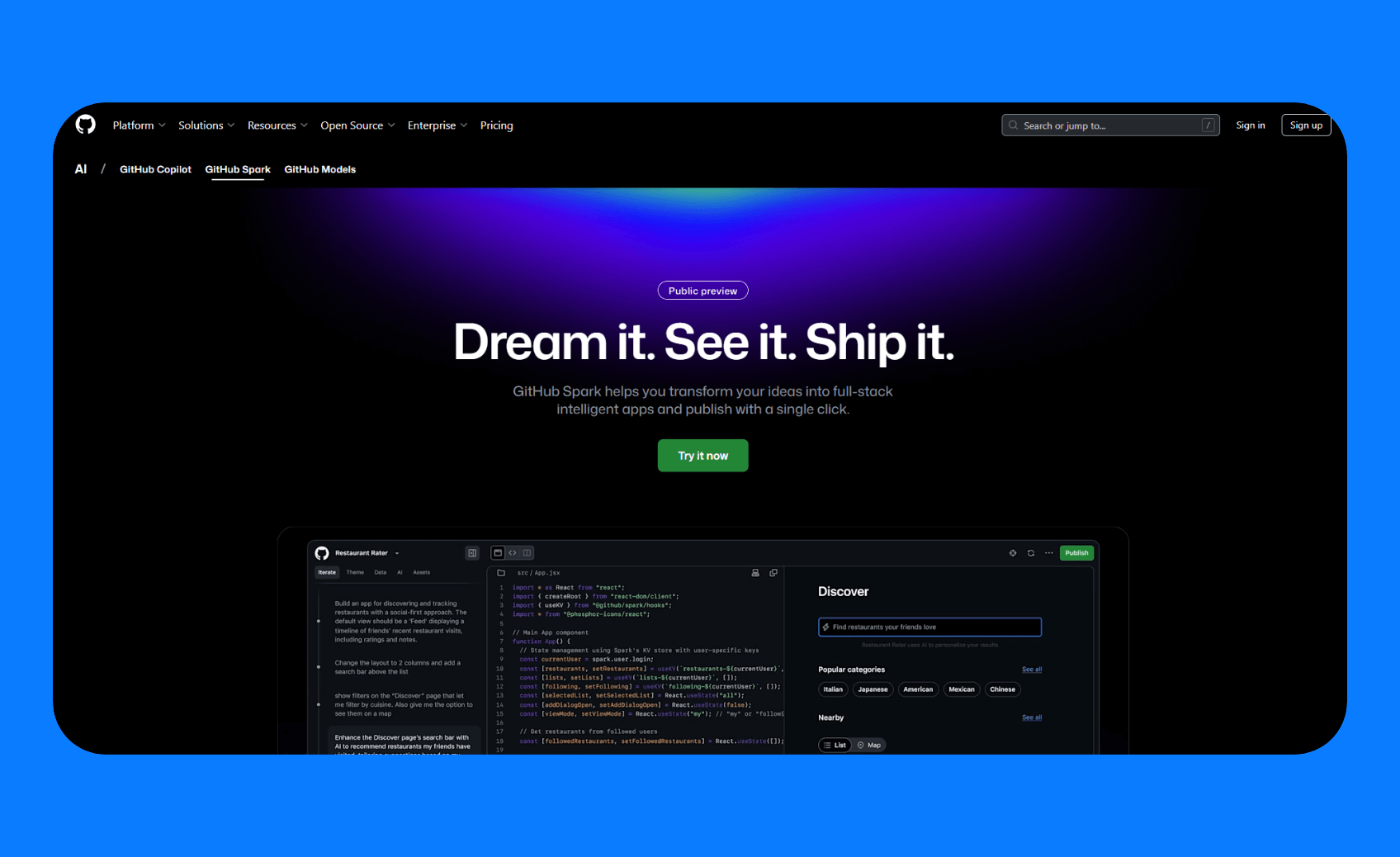
What it does: GitHub Spark is an AI-powered, app-centric platform from GitHub for building, previewing, and deploying full-stack apps directly from natural language prompts.
Who it’s for: Spark is great for developers (or teams) who already use GitHub and want to prototype applications using generative AI.
Key features
- Mixed-mode development: After Spark generates the initial app, you can use Copilot Chat on the code within Spark’s editor, or open the project in VS Code to code manually.
- One-click deployment with GitHub auth: When you’re ready, you hit publish, and it deploys the app to a managed service.
- Persistent data storage: Spark includes a managed key-value store and visual data editor for seamless back-end and state management, without requiring database setup.
Pros
- Provides instant deployment and hosting: Spark hosts the apps you generate with no setup, infrastructure, or manual deployment required.
- Enables UI customization with themes: You can tailor the app’s appearance using the built-in design system and theming options.
- Integrates deeply with GitHub: Spark supports source control, Copilot/agent-mode coding, and collaboration features familiar to developers, while remaining highly accessible to non-coders.
Cons
- GitHub-centric by design: Spark is less appealing if you’re not using GitHub or you prefer other version control platforms.
- Public preview: Spark is still in public preview, and access is limited to Copilot+ subscribers.
Pricing
Spark itself has no separate cost but is included with GitHub Copilot Pro+, which costs $39/user/month.
Bottom line: GitHub Spark is a good alternative if you already have a Copilot Pro+ subscription and need AI app generation.
6. Glide
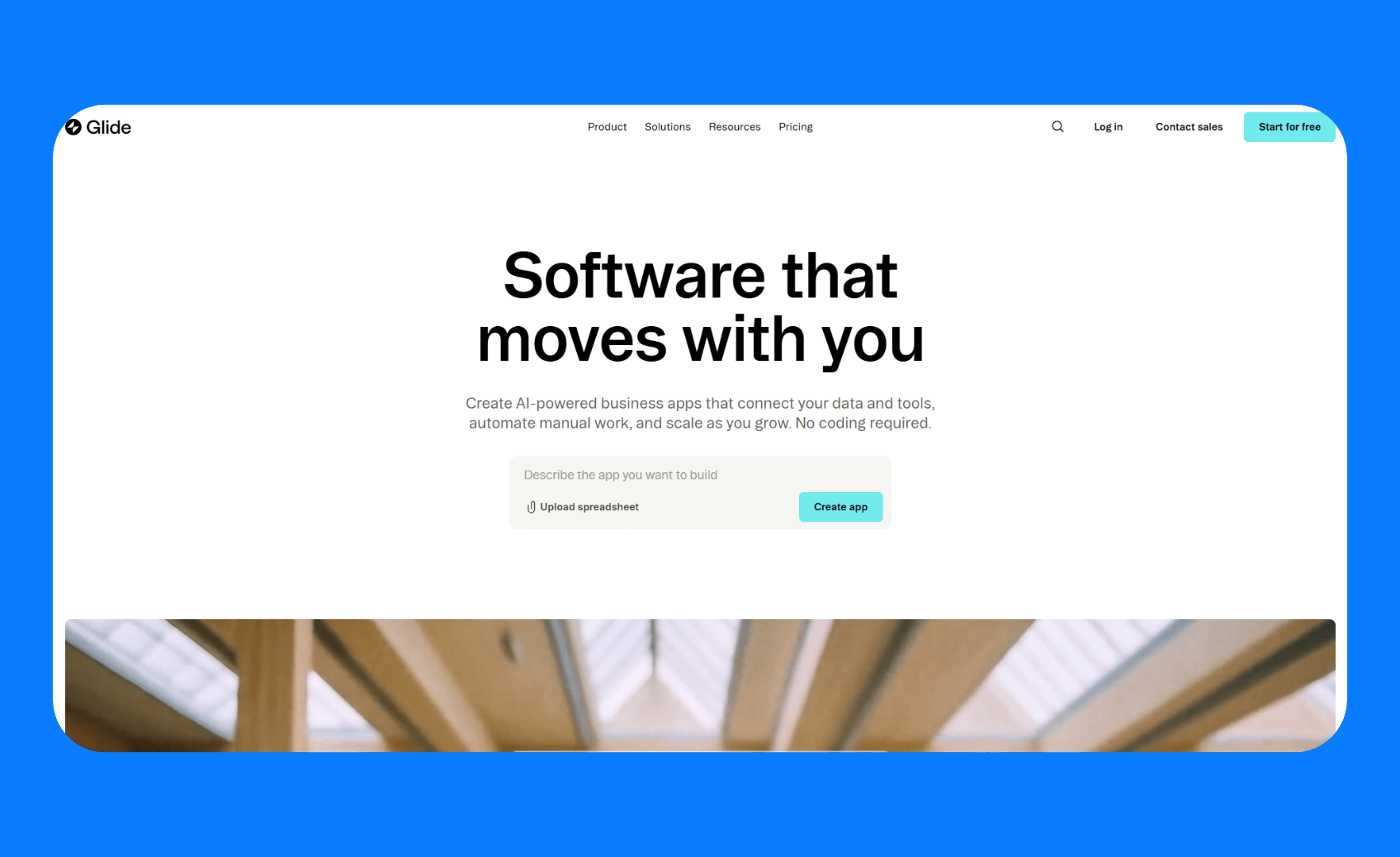
What it does: Glide is a no-code app builder that now incorporates AI features to accelerate development. You can create business apps by connecting to a data source (like a Google Sheet, Excel, or database) and then visually designing an interface using pre-built components.
Who it’s for: Operations teams, non-developers, and DIY entrepreneurs who need to quickly build an app on top of their data.
Key features
- Spreadsheet-driven app building: Users start by connecting Google Sheets, Excel, or Glide Tables. Glide maps data rows directly to app entries, making it simple to transform existing, structured data into an interactive app.
- Visual drag-and-drop designer: It has an editor to visually build app screens, add components (text, buttons, forms, lists), and customize layouts with pre-designed themes.
- AI integrations: Glide has built-in AI features that generate app logic, automate workflows, summarize data, or extract information from images. You can also auto-generate UIs and actions using natural language.
Pros
- Built-in cross-platform support: Glide apps automatically work on web and mobile as progressive web apps.
- Easy data management: Glide’s data editor (which looks like a spreadsheet) makes it easy to manage and visualize your app data in one place.
- Fast iteration: The intuitive drag-and-drop editor and spreadsheet-driven logic let non-coders create apps quickly.
Cons
- Less flexible for complex features: You are limited to the components and logic it provides. If you need a truly custom UI or some intricate server-side logic, Glide might not support it.
- Scaling and performance issues: There are row limits on data, depending on your plan and update frequency limits. If your app grows substantially, you might eventually need to migrate to a custom solution.
Pricing
Glide’s free tier supports 1 app, 10 personal users, and up to 25k rows. The paid plans start at $19/month, billed annually. It supports 100 personal users, workflows, integrations, and access to AI features.
Bottom line: Glide is best for small-to-medium teams building data-driven internal tools where fast delivery and UX consistency matter more than pixel-perfect customization.
7. n8n
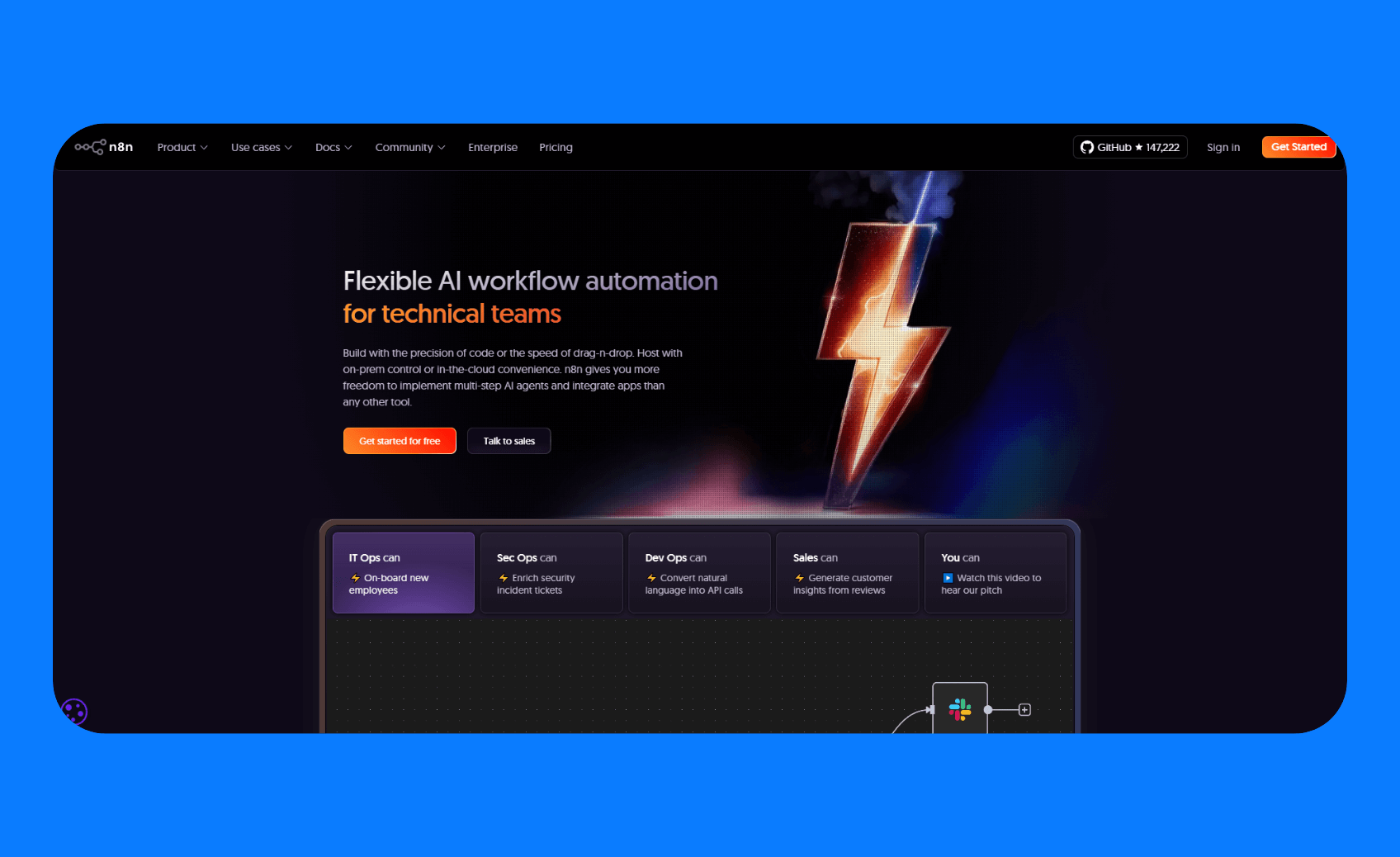
What it does: n8n is an open-source AI workflow automation tool for creating backend workflows, connecting different services, and automating processes without writing glue code.
Who it’s for: Developers or tech-savvy teams who need to automate and integrate various systems and prefer a no-code/low-code approach.
Key features
- Visual workflow builder: n8n’s canvas allows you to drag nodes and connect them in sequence to define a workflow.
- Extensive integrations: n8n comes with a huge library of pre-built integrations (nodes) for common apps and APIs, plus an HTTP request node for custom connections.
- Agent integration: It has native LLM integration and cluster/agent nodes for building Retrieval Augmented Generation (RAG) pipelines and specialized AI agents.
Pros
- Full control and privacy: Because you can self-host, you have full control over the infrastructure and data security.
- Extendable and developer-friendly: You can write custom code at points of your choosing, or even develop new nodes (in TypeScript) to contribute or for your private use.
Cons
- Self-hosting overhead: On-premise deployment requires DevOps skills, ongoing server management, and troubleshooting.
- Learning curve for complex workflows: As workflows get complex, the canvas can become difficult to manage. Debugging flows with many nodes is also challenging.
Pricing
n8n plans start at $20 per month, billed annually for 2.5k workflow executions with unlimited workflows, steps, and users. Self-hosted plans start at $667 per month, billed annually for 40k workflow executions.
Bottom line: n8n is best for technical teams, automation engineers, and businesses prioritizing data control and have custom complex workflows, rather than those needing easy out-of-the-box automations.
Other Bolt.new alternatives to consider include:
Beyond the top players we’ve broken down in detail, there are several other AI and low-code platforms worth mentioning:
- Firebase Studio: Google’s AI app builder that uses Gemini models to prototype, build, and deploy full-stack apps on Google Firebase.
- Windsurf: AI-centric code editor/IDE similar to Cursor, though on top of offering a standalone editor, it has a plugin for other IDEs.
- Retool: Low-code app builder with self-hosting options and mobile app building support. You can also use Retool for external-facing apps.
- UI Bakery: Low-code platform for building internal tools, which recently introduced an AI App Generator feature that combines prompt-based generation with UI Bakery's traditional drag-and-drop editor.
- Replit: Cloud-based collaborative coding platform with AI Agent capabilities that can build full applications from natural language descriptions.
How to choose the right Bolt.new alternative
You should choose a Bolt.new alternative based on your project goals, technical skills, and compliance needs.
Here are some key considerations:
- Security features: Individual or small teams building a quick MVP can use tools like Lovable, Spark, or v0. Enterprise teams also need security and governance features provided by tools like Superblocks.
- Complexity and customization: If you want fine-grained control and don’t mind coding, Cursor or Windsurf are strong choices. If you’d rather avoid code entirely, look at tools that also offer visual builders like Glide, Superblocks, or UI Bakery.
- Pricing considerations: Some platforms (e.g., v0 or Firebase Studio) start free or low-cost. Others use token-based pricing that can spike with heavy usage. Subscription-based models are more predictable.
- Compliance: Regulated industries require more control over their data. Superblocks offers a hybrid model that keeps data within your VPC. UI Bakery and n8n allow full self-hosting for maximum control, though this comes with infrastructure and management overhead.
- Customization vs. speed: Prompt-to-app builders excel at speed but aren’t always production-ready. You’ll likely need to export the code and refine it in a dev environment. Most of the AI tools we’ve discussed give you that option.
My final verdict
Superblocks is the strongest overall Bolt.new alternative for building internal tools. Its security and governance features bridge the gap between rapid development and enterprise requirements.
However, if you’re not building internal business tools, consider using:
- Lovable, Spark, Replit, Firebase Studio, or v0 to build MVPs and first iterations.
- Cursor and Windsurf to build apps fast in the IDE.
- Glide to build interfaces for your data.
- n8n to build agentic workflows.
And remember, you can combine solutions. Perhaps use Superblocks to generate your internal tool, then move into Cursor or Windsurf to refine the app.
Build with secure internal apps with Superblocks
Superblocks supports AI app generation with built-in governance controls. Engineering and business teams can build quickly without introducing security or compliance gaps. This is a core challenge most orgs face when building with AI.
We’ve looked at the key features that enable this, but just to quickly recap:
- Flexible development modalities: Teams can use Clark to generate apps from prompts, the WYSIWYG drag-and-drop editor, or code. Superblocks syncs the changes you make in code and the visual editor.
- Context-aware AI app generation: Every app built with Clark abides by organizational standards for data security, permissions, and compliance. This addresses the major LLM risks of ungoverned shadow AI app generation.
- Centrally managed governance layer: Superblocks supports granular access controls with RBAC, SSO, and audit logs, all centrally governed from a single pane of glass across all users. It also integrates with secret managers for safe credentials management.
- Extensive integrations: It can integrate with any API or databases. These integrations include your SDLC processes, like Git workflows and CI/CD pipelines.
Ready for enterprise-grade governance? Book a demo with one of our product experts.
Frequently asked questions
What is the best Bolt.new alternative in 2025?
Superblocks is the top Bolt.new alternative in 2025 for internal tools, because it offers enterprise-ready AI app generation. It generates full-stack internal apps from prompts while enforcing your security, compliance, and coding standards automatically.
What should I look for in a Bolt competitor?
Evaluate Bolt.new competitors on:
- How well they handle complex business logic or more users and data
- How they fit into your tech stack (deployment or integrations)
- The degree of control they give you for customizing and maintaining apps in the future
Is Superblocks better than Bolt.new for enterprises?
Superblocks is better than Bolt for enterprise applications because it includes key enterprise features such as single sign-on, role-based access control, audit logs, and on-prem deployment for its data.
Which Bolt.new competitors are best for small teams?
The best Bolt.new competitors for small teams are Lovable, UI Bakery, V0 by Vercel, and Replit. These platforms are known for beginner-friendly interfaces and affordable pricing.
How much do Bolt alternatives cost?
Paid plans for Bolt alternatives range from $20 to $40 per month. For example, Lovable starts at $25/month for a paid plan, Cursor is $20/month per user, and GitHub Spark $39/month.
Is there a low-code alternative to Bolt.new?
Yes, you can use low-code alternatives like ToolJet, Appsmith, and Retool. ToolJet and Appsmith are open-source development options. ToolJet is leaning heavily into AI with features like an AI agent builder. Retool, on the other hand, has been around longer and is well-known for its large integration ecosystem and extensive template library.
Stay tuned for updates
Get the latest Superblocks news and internal tooling market insights.
You've successfully signed up
Request early access
Step 1 of 2
Request early access
Step 2 of 2
You’ve been added to the waitlist!
Book a demo to skip the waitlist
Thank you for your interest!
A member of our team will be in touch soon to schedule a demo.
Table of Contents



.png)


